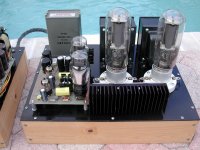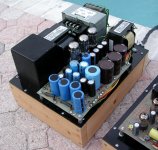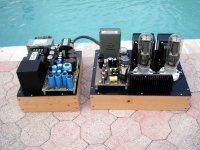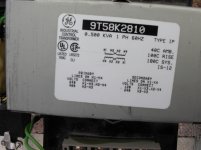These industrial control transformers are a real bargain for a rugged potted transformer. They are typically used (step-down) next to large-motor 3 phase 440v industrial equipment to give you a local 120v outlet maybe on the side of a machine so you can run a laptop etc. This one has 6 different primary voltages. The ratios look pretty good if these can be used as low-cost step up transformers for under 200ma? Can they be used that way?
Micron CTL Transformer 50VA CE Mark B050-2001-GA | Zoro.com
Micron CTL Transformer 50VA CE Mark B050-2001-GA | Zoro.com
My 845SE amp uses a 500 VA industrial control transformer that has two 240 volt windings for the "primary" and two 120 volt windings for the "secondary."
I paralled both 120 volt windings and fed them line voltage. The 240 volt windings are connected in series, which feeds a voltage doubler made with 5AR4's. B+ is about 1100 volts with no load and 1050 with each 845 sucking 80 mA. There is no buzz, but the transformer does get a bit warm. Power output is 30 WPC.
I paralled both 120 volt windings and fed them line voltage. The 240 volt windings are connected in series, which feeds a voltage doubler made with 5AR4's. B+ is about 1100 volts with no load and 1050 with each 845 sucking 80 mA. There is no buzz, but the transformer does get a bit warm. Power output is 30 WPC.
Attachments
the ratio is designed 5%-10% high to allow for sag.
The cheaper the transformer, the wider the difference in ratio is. That, and my 122 to 126 volt line is how I get 170 volts of B+ from a Triad N68-X (wired per instructions).
> The cheaper the transformer, the wider the difference
You can expand on that.
Small transformers have higher losses (what the ratio-difference covers).
A 10VA transformer may have 25% sag (and at no-load be 25% high; or low if reversed).
The 25,000VA street-transformer to power two houses has loss like 2% (and the ratio is near exact).
Partly because the geometric scaling encourages this trend.
Also because of economics. Nobody cares about the losses in a 10VA job. It won't overheat (geometric scaling). The running cost is pennies. And is paid by the buyer, who is only looking at first-cost. Yes, many small transformers are just cheap. OTOH the losses in a 25KVA job run real money. And the buyers of these things figure-out the running cost over 40 years. They will pay for finer iron and fatter copper if it saves money over the life of the transformer.
In the 50VA-200VA world we live in, 10% is a rough first-guess of sag and ratio compensation. Sometimes you can deduce from specs, in any case you should plan on the ratio being somewhat different than the normal-connection full-load spec implies.
You can expand on that.
Small transformers have higher losses (what the ratio-difference covers).
A 10VA transformer may have 25% sag (and at no-load be 25% high; or low if reversed).
The 25,000VA street-transformer to power two houses has loss like 2% (and the ratio is near exact).
Partly because the geometric scaling encourages this trend.
Also because of economics. Nobody cares about the losses in a 10VA job. It won't overheat (geometric scaling). The running cost is pennies. And is paid by the buyer, who is only looking at first-cost. Yes, many small transformers are just cheap. OTOH the losses in a 25KVA job run real money. And the buyers of these things figure-out the running cost over 40 years. They will pay for finer iron and fatter copper if it saves money over the life of the transformer.
In the 50VA-200VA world we live in, 10% is a rough first-guess of sag and ratio compensation. Sometimes you can deduce from specs, in any case you should plan on the ratio being somewhat different than the normal-connection full-load spec implies.
A beautiful looking amp,
You didn't look too closely. The top plate was once a road sign that was deposited in my backyard during a hurricane. The wood is scrap pine and it's held together with sheetrock screws. There isn't a straight corner in either box, and theyr'e all butt joints. Ten years of weekly wood shop classes at a local night school have occurred since I built that amp, and I do a bit better now.
but do you have problems with the tubes heating the capacitors?
The driver board is the very first prototype of one of my original TSE amps. It's running 45's which only dissipate about 10 watts each. There are three 5AR4's in the power supply which do put out some heat, and the row of caps next to them get rather warm but not too hot to touch. The 211's or 845's dissipate 100 to over 150 watts each.....that, and all the other losses turned out to be the problem.
I built this amp in 2004. At that time my lab, listening room, and workshop was all confined to a 10 X 10 foot room with poor airflow and I lived in south Florida. That amp pumped 500+ watts of heat into the room which was sufficient to raise the temperature to unbearable in about an hour. For this reason the amp saw very little use.
When my 41 year career at Motorola ended, I packed up everything and moved 1200 miles north. Two winters ago I dug the amp out of it's box and plugged it in, at which point a fireworks display erupted inside one of the 5AR4's and the fuse blew.....I still have not investigated, but maybe one of those caps next to the 5AR4's did die.
I have waffled between fixing it, and completely rebuilding it......so nothing at all has happened. There is EXPOSED plate voltage on the top of the amp and power supply, and I get surprise visits by young grandkids now, so that death box remains safely up on the shelf far from a power outlet for now.
- Status
- This old topic is closed. If you want to reopen this topic, contact a moderator using the "Report Post" button.
- Home
- Amplifiers
- Power Supplies
- Industrial (step-down) control transformers used in reverse?



